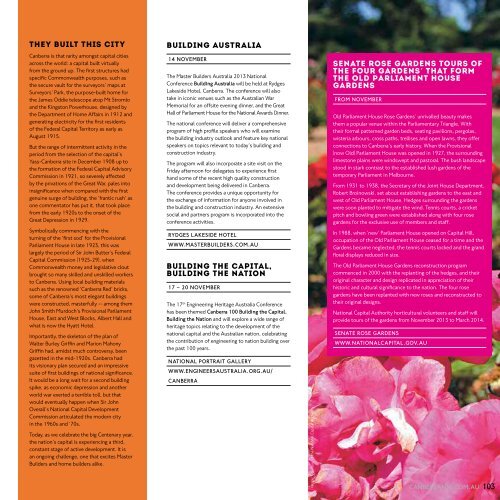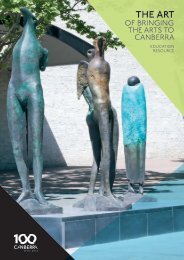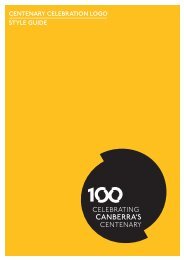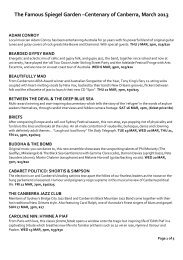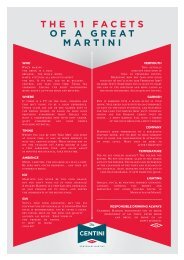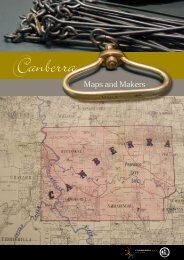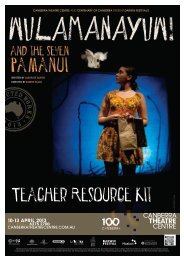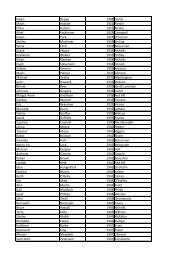WINTERâSPRING - Canberra 100
WINTERâSPRING - Canberra 100
WINTERâSPRING - Canberra 100
You also want an ePaper? Increase the reach of your titles
YUMPU automatically turns print PDFs into web optimized ePapers that Google loves.
They Built This City<br />
building australia<br />
<strong>Canberra</strong> is that rarity amongst capital cities<br />
across the world: a capital built virtually<br />
from the ground up. The first structures had<br />
specific Commonwealth purposes, such as<br />
the secure vault for the surveyors' maps at<br />
Surveyors' Park, the purpose-built home for<br />
the James Oddie telescope atop Mt Stromlo<br />
and the Kingston Powerhouse, designed by<br />
the Department of Home Affairs in 1912 and<br />
generating electricity for the first residents<br />
of the Federal Capital Territory as early as<br />
August 1915.<br />
But the range of intermittent activity in the<br />
period from the selection of the capital's<br />
Yass-<strong>Canberra</strong> site in December 1908 up to<br />
the formation of the Federal Capital Advisory<br />
Commission in 1921, so severely affected<br />
by the privations of the Great War, pales into<br />
insignificance when compared with the first<br />
genuine surge of building, the 'frantic rush' as<br />
one commentator has put it, that took place<br />
from the early 1920s to the onset of the<br />
Great Depression in 1929.<br />
Symbolically commencing with the<br />
turning of the 'first sod' for the Provisional<br />
Parliament House in late 1923, this was<br />
largely the period of Sir John Butter's Federal<br />
Capital Commission (1925-29), when<br />
Commonwealth money and legislative clout<br />
brought so many skilled and unskilled workers<br />
to <strong>Canberra</strong>. Using local building materials<br />
such as the renowned '<strong>Canberra</strong> Red' bricks,<br />
some of <strong>Canberra</strong>'s most elegant buildings<br />
were constructed, masterfully -- among them<br />
John Smith Murdoch's Provisional Parliament<br />
House, East and West Blocks, Albert Hall and<br />
what is now the Hyatt Hotel.<br />
Importantly, the skeleton of the plan of<br />
Walter Burley Griffin and Marion Mahony<br />
Griffin had, amidst much controversy, been<br />
gazetted in the mid-1920s. <strong>Canberra</strong> had<br />
its visionary plan secured and an impressive<br />
suite of first buildings of national significance.<br />
It would be a long wait for a second building<br />
spike, as economic depression and another<br />
world war exerted a terrible toll, but that<br />
would eventually happen when Sir John<br />
Overall's National Capital Development<br />
Commission articulated the modern city<br />
in the 1960s and '70s.<br />
Today, as we celebrate the big Centenary year,<br />
the nation's capital is experiencing a third,<br />
constant stage of active development. It is<br />
an ongoing challenge, one that excites Master<br />
Builders and home builders alike.<br />
14 November<br />
The Master Builders Australia 2013 National<br />
Conference Building Australia will be held at Rydges<br />
Lakeside Hotel, <strong>Canberra</strong>. The conference will also<br />
take in iconic venues such as the Australian War<br />
Memorial for an offsite evening dinner, and the Great<br />
Hall of Parliament House for the National Awards Dinner.<br />
The national conference will deliver a comprehensive<br />
program of high profile speakers who will examine<br />
the building industry outlook and feature key national<br />
speakers on topics relevant to today’s building and<br />
construction industry.<br />
The program will also incorporate a site visit on the<br />
Friday afternoon for delegates to experience first<br />
hand some of the recent high quality construction<br />
and development being delivered in <strong>Canberra</strong>.<br />
The conference provides a unique opportunity for<br />
the exchange of information for anyone involved in<br />
the building and construction industry. An extensive<br />
social and partners program is incorporated into the<br />
conference activities.<br />
Rydges Lakeside Hotel<br />
www.masterbuilders.com.au<br />
building the capital,<br />
building the nation<br />
17 – 20 november<br />
The 17 th Engineering Heritage Australia Conference<br />
has been themed <strong>Canberra</strong> <strong>100</strong> Building the Capital,<br />
Building the Nation and will explore a wide range of<br />
heritage topics relating to the development of the<br />
national capital and the Australian nation, celebrating<br />
the contribution of engineering to nation building over<br />
the past <strong>100</strong> years.<br />
national portrait gallery<br />
www.engineersaustralia.org.au/<br />
canberra<br />
Image: Courtesy of the National Capital Authority.<br />
Senate Rose Gardens tours of<br />
the four gardens' that form<br />
the Old Parliament House<br />
gardens<br />
from November<br />
Old Parliament House Rose Gardens' unrivalled beauty makes<br />
them a popular venue within the Parliamentary Triangle. With<br />
their formal patterned garden beds, seating pavilions, pergolas,<br />
wisteria arbours, cross paths, trellises and open lawns, they offer<br />
connections to <strong>Canberra</strong>'s early history. When the Provisional<br />
(now Old) Parliament House was opened in 1927, the surrounding<br />
limestone plains were windswept and pastoral. The bush landscape<br />
stood in stark contrast to the established lush gardens of the<br />
temporary Parliament in Melbourne.<br />
From 1931 to 1938, the Secretary of the Joint House Department,<br />
Robert Broinowski, set about establishing gardens to the east and<br />
west of Old Parliament House. Hedges surrounding the gardens<br />
were soon planted to mitigate the wind. Tennis courts, a cricket<br />
pitch and bowling green were established along with four rose<br />
gardens for the exclusive use of members and staff.<br />
In 1988, when 'new' Parliament House opened on Capital Hill,<br />
occupation of the Old Parliament House ceased for a time and the<br />
Gardens became neglected, the tennis courts locked and the grand<br />
floral displays reduced in size.<br />
The Old Parliament House Gardens reconstruction program<br />
commenced in 2000 with the replanting of the hedges, and their<br />
original character and design replicated in appreciation of their<br />
historic and cultural significance to the nation. The four rose<br />
gardens have been replanted with new roses and reconstructed to<br />
their original designs.<br />
National Capital Authority horticultural volunteers and staff will<br />
provide tours of the gardens from November 2013 to March 2014.<br />
Senate Rose Gardens<br />
www.nationalcapital.gov.au<br />
canberra<strong>100</strong>.com.au 103


